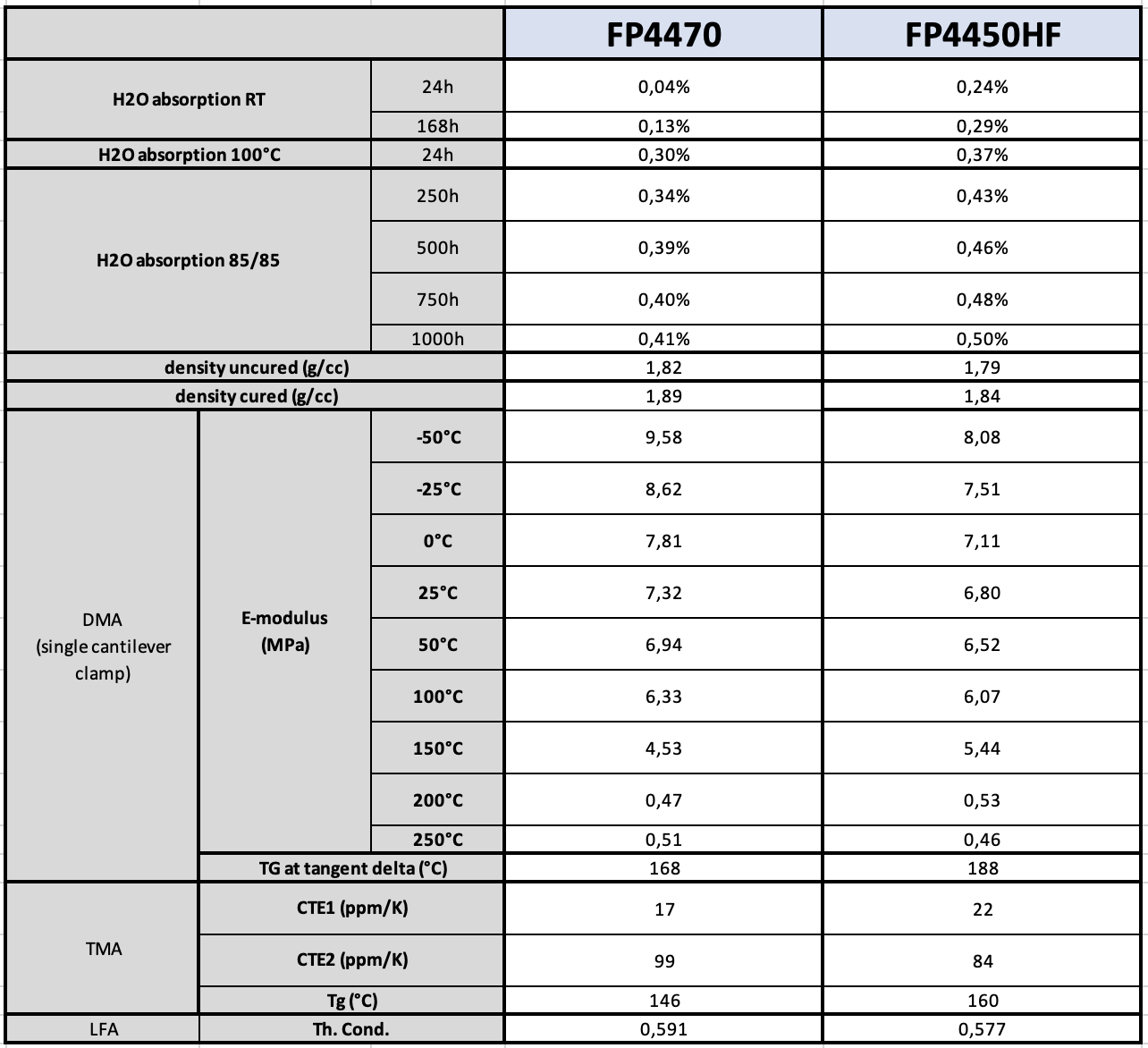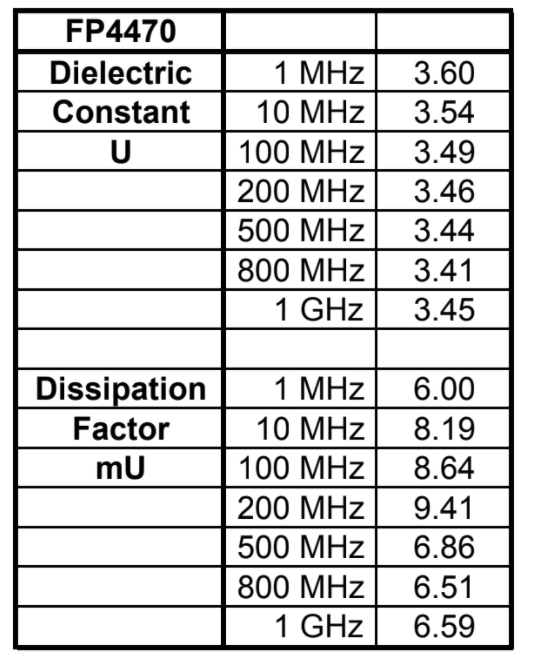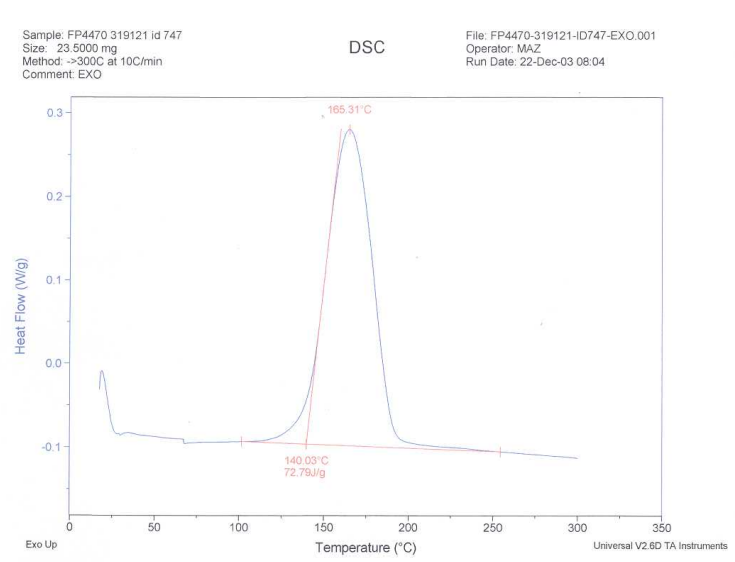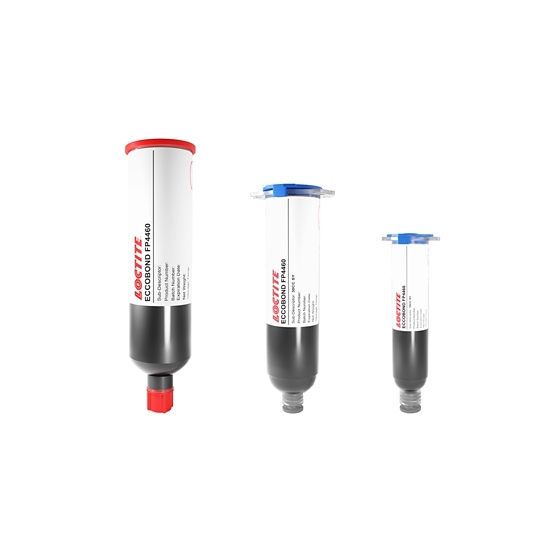LOCTITE ECCOBOND FP4470
- High purity
- Green product
- Handles solder reflow temperatures
Product Description
LOCTITE ECCOBOND FP4470 is a silica/anhydride material (known in the US as CB0260) that features excellent flow properties allowing the material to penetrate fine pitch wires and deep cavities without entrapping voids. This proven epoxy encapsulant is used in high-reliability aerospace applications.
LOCTITE ECCOBOND FP4470 can withstand solder reflow after being exposed to JEDEC Level 2A (60°C/60% RH, 120 hours) preconditioning. It is a high adhesion version of FP4450 that handles higher solder reflow temperatures when necessary. In most cases it can be applied in the same way as 4450 with the same results and actually with lower moisture absorption.
Cure Schedule
- 30 minutes @ 125°C + 90 minutes @ 165°C
LOCTITE ECCOBOND FP4470 should be dispensed onto a substrate warmed to approximately 75°C.
Technical Specifications
| General Properties | |||||||||
| Filler Content | 75 % | ||||||||
| Pot Life Pot Life Pot life is the amount of time it takes for the viscosity of a material to double (or quadruple for lower viscosity materials) in room temperature after a material is mixed. It is closely related to work life but it is not application dependent, less precise and more of a general indication of how fast a system is going to cure. | 72 hours | ||||||||
| Specific Gravity Specific Gravity Specific gravity (SG) is the ratio of the density of a substance to the density of a reference substance; equivalently, it is the ratio of the mass of a substance to the mass of a reference substance for the same given volume. For liquids, the reference substance is almost always water (1), while for gases, it is air (1.18) at room temperature. Specific gravity is unitless. | 1.8 | ||||||||
| |||||||||
| Thermal Properties | |||||||||
| Glass Transition Temperature (Tg) Glass Transition Temperature (Tg) The glass transition temperature for organic adhesives is a temperature region where the polymers change from glassy and brittle to soft and rubbery. Increasing the temperature further continues the softening process as the viscosity drops too. Temperatures between the glass transition temperature and below the decomposition point of the adhesive are the best region for bonding. The glass-transition temperature Tg of a material characterizes the range of temperatures over which this glass transition occurs. | 148 °C | ||||||||
| |||||||||
| |||||||||
| Other Properties | |||||||||
| MSL Level | MSL 2A | ||||||||
| Mechanical Properties | |||||||||
| |||||||||
| |||||||||
| Chemical Properties | |||||||||
| Water Absorption | 0.5 % | ||||||||
| |||||||||
| Physical Properties | |||||||||
| Viscosity Viscosity Viscosity is a measurement of a fluid’s resistance to flow. Viscosity is commonly measured in centiPoise (cP). One cP is defined as the viscosity of water and all other viscosities are derived from this base. MPa is another common unit with a 1:1 conversion to cP. A product like honey would have a much higher viscosity -around 10,000 cPs- compared to water. As a result, honey would flow much slower out of a tipped glass than water would. The viscosity of a material can be decreased with an increase in temperature in order to better suit an application | 42,000 mPa.s | ||||||||
Additional Information
How does this product fare compared to the rest of the close FP family?
FP 4470 uses the same hardener system as 4450, but the epoxy/anhydride resin system is slightly more different compared to FP 4450(HF). Tg is lower and 4470 has few % higher filler loading for lower CTE (19 vs 17ppm). FP 4470 also has smaller filler particle size (<50um) vs FP 4450 and higher adhesion vs FP 4450(HF).
We have internal information showing that these legacy semiconductor liquids pass UL94HB at 1/8” thickness but do not have the test data or yellow card nor are we going to test for it. This is anecdotal but, hopefully, helpful.
The following are some older tested values for your assistance and information but, by no means, guaranteed specifications.


DSC Curve
The on-set temperature of FP4470 is around 140 Celsius as calculated by the X-section of the 2 red lines. You can imagine that the positioning of the red lines is a bit “subjective”, so different people & different software can get slightly different results from the same curve. Nevertheless, this is widely accepted as the “standard” method of calculating the on-set temperature.
A more interesting point is that the calculated on-set is always higher than the START of CURE. This is where the material starts to exotherm, and the baseline deviates upwards from a straight line. In this case it is 100 Celsius, so curing at 140C or 150C should be OK (similar to FP 4450 for which we recommend 165° Celsius cure, but companies have been using 140 Celsius for decades due to their "sensitive components".

Can I get the yield strength of FP4470?
Typically, we do not measure yield points on this style of product. The materials are relatively rigid and show very little elastic behaviour.
One way to demonstrate this is to run a die shear test. Some equipment (eg from Dage) will record & plot a stress/strain curve as the test is performed. We have not examined the plots from these specific materials, but we doubt they will show any significant elastic or plastic properties.
Material Property | FP4450 | FP4470 (CB0260) |
Color | Black | Grey/Black |
Specific Gravity | 1.77 | 1.8 |
Viscosity, cps (25°C 7/20) | 53000 | 42000 |
DSC gel onset (°C), 10°C/min ramp rate | 110/138 | 140/165 |
Gel Time (121°C, minutes) | 12 | 12 |
Pot life (25°C, days) | 3 | >5 |
Shelf Life (-40°C), months | 9 | 9 |
Cure Time, minutes | 30/90 | 30/90 |
Cure Temperature, °C | 125/165 | 125/165 |
Container Size | 30cc | 30cc |
Filler Type | Silica | Silica |
Hardener Type | Anhydride | Anhydride |
Maximum Filler Size (microns) | 120 | 50 |
Average Filler Size (microns) | 35 | 8 |
CTE1 (ppm/°C) | 19 | 17 |
CTE2 (ppm/°C) | 72 | 64 |
Filler Weight (%) | 73 | 75 |
Tg (°C) by TMA | 159 | 148 |
Thermal Conductivity (W/mK) | 0.63 | 0.7 |
Flexural Modulus @25°C, Gpa | 10.2 | 12.7 |
Flexural Modulus @ 240°C, Gpa |
| 0.6 |
Flexural Strength @25°C, Mpa | 114 | 137 |
Flexural Strength @ 240°C, Mpa |
| 17 |
Young's Modulus (Tensile Modulus), Gpa | 13.5 |
|
Tensile Strength, Mpa | 62.1 |
|
Poisson's Ratio | 0.33 | 0.33 |
Elongation at break, % | 1.81 |
|
Moisture Uptake, % (168hrs PCT) | 0.8 | 0.5 |
Extractable Ionics (ppm; Na; Cl) | 2; 7 | 1; 3 |
Linear Shinkage (%) | 0.57 |
|
Shore D Harness @ RT |
| 90 |
Thermal Stability (TGA), 10°C/min ramp rate | 310/368 | 106 / 369 |
Oxygen Index | 45.5 | 49.0 |
Alpha Count (alpha counts/ cm2 hr) | 0.005 | <0.001 |
Dielectric Constant @ 100KHz | 3.62 | 3.5 1MHz |
Dissipation Factor | 0.004 | 0.001 |
Dielectric Breakdown (V/mil) | 904.1 |
|
Volume Resistivity @100V, Ohm-cm | 2.18E+16 | 5E+16 |
Surface Resistivity @100V, Ohms | 2.57E+16 |
|
Flammability, 1/8" thickness | UL94HB | UL94HB |
Specific Heat J/kg-K | 1105 | 1078 |
Rheology @ 80°C, ps | 120 | 10 |
Glob Height, mm | 0.5 | 0.92 |
JEDEC Testability (internal) | none | L2A |
RoHS Done? | Yes | Yes |
No available data for Dielectric strength. According to our scientists a highly silica filled encapsulant will have a range of 20 to 40Kv/mm.



